Museums are places where we talk about big issues. The biggest planetary issue we face today is 'global change', the collective term used by the Intergovernmental Panel on Climate Change (IPCC). The term encompasses climate change, global warming and extreme weather events, as well as the responses to these of economies, governments and individuals. The prominence of global change and its importance in society make it a tantalising issue for all sorts of museums. The different facets of the problem demand a crosscutting approach that ideally can accommodate information about the science of climate change, innovation and design for adapting to change, while at the same time addressing the ethics of environmental justice and intergenerational equity.
There are two barriers for museum exhibition planners. The first is that 'big issues' are not the same thing as big objects. Exhibitions rely on objects to engage an audience: they need real stuff. The second is that climate change is generally framed as a problem of the future (even where there is strong evidence for it in the present), so this poses a design challenge. Experts talk about a 'transition to sustainability', but this journey metaphor is hard to translate into static museum displays and it is too abstract for a good storyline.
Our understanding of climate change is most often framed by IPCC reports and numbers. IPCC assessments are heavily skewed toward natural science disciplines, especially the earth sciences. Social science content is limited and heavily dominated by economics, the social science that is most dedicated to 'future scenarios'. Mike Hulme, in a recent commentary, noted that 'literature from the humanities was virtually absent' in discussions of global change. The IPCC's view of climate change that influences policy 'continues to be dominated by positivist disciplines at the expense of interpretative ones'.[1] Museums with a disciplinary bias towards the humanities have an opportunity to counterbalance and complement the dominant discourse of climate change, but they need objects and frameworks that can serve this end.
In this short review essay I compare two major museum exhibitions on climate change that rely heavily on the IPCC models: Uppdrag Klimat (Mission: Climate Earth), at the Royal Natural History Museum in Stockholm (Naturhistoriska Riksmuseet), Sweden; and EcoLogic, at the Powerhouse Museum, Sydney. The first is a natural history museum and the second a social history museum; the exhibitions in each place build on their strengths. I then consider two other museum initiatives: Northern Worlds, at the National Museum of Denmark (Nationalmuseet), Copenhagen, running from 2009 to 2013; and Isens arkeologi — funn fra fonner i fjellet (The Archaeology of Ice — Finds from a Frozen Past), opening at the Cultural History Museum of the University of Oslo (Kulturhistorisk Museum) on 8 September 2011, as part of the museum's 200-year jubilee celebrations.[2] Both of these display local research in archaeology and the history of human societies, thus reframing some of the global change questions.
The Natural History Museum in Stockholm developed its exhibition Mission: Climate Earth in 2007. It was a major feature of the first World Congress on Resilience, held in Stockholm in April 2008. The museum was a partner-organiser of this major event, which also launched the Stockholm Resilience Centre. It comprises eight modules (in Swedish, with English summaries):
'Weather — climate in an instant'
'The sun — motor of the climate'
'Climate: then and now'
'How the climate works'
'Solutions are available'
'What may happen?'
'Eye of the storm'
'Perspective on the future'
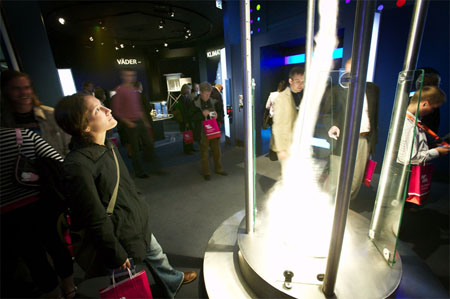
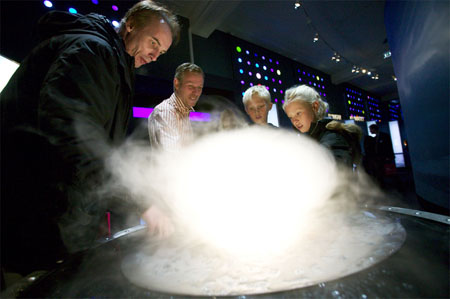
EcoLogic was billed as a 'new' exhibition in 2011, but in fact it is a revision of an existing design exhibition on 'creating a sustainable future' that opened 10 years earlier.[5] The climate change elements comprise several new modules, converting the exhibition from one that focused on sustainable living, to one that specifically addresses the threat of global warming. Thus the museum's interest in innovation and design in industry provides a very different context for some of the same IPCC-generated facts about climate change. There are some features that are very similar to the Stockholm exhibition: a panel on El Niño weather patterns includes the same graphic, in fact, but ties the story to Australian conditions. Both exhibitions feature a panel headed 'Planning for the future', but in Sydney this focuses on the city's specific water needs, rather than a global scenario.
The entrance feature is a new three-dimensional carbon dioxide timeline. The bars of the histograms have leapt off the page and become physical posts. This is a 'design' solution to make carbon dioxide itself into a 'big object'. The posts look great, but the three centuries are on different scales, so while we see increases each century, each row of posts rises with a very similar slope. One misses altogether the dramatic sense of cumulative effect that the well-known hockey stick curve can give at a glance. The screen that accompanies the carbon dioxide posts features rather cute cartoon sheep (with Canadian accents) providing facts about emissions. The facts were either global, or offered detailed local information about Canada, which seemed a bit odd in a museum in Sydney. By contrast, another imported short film, a Norwegian cartoon about Carbon Emissions Trading, is rather more successful, as it focuses on the economic principles and how they work in general practical terms, rather than including specific data from Norway or anywhere else.
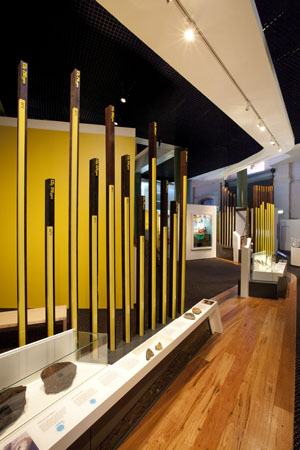
photograph by Geoff Friend
© Powerhouse Museum, Sydney
In the case of other climate change stories, efforts have been made to find authentic local objects to accompany the 'message', if not exactly to illustrate it. For example, 'Global warming risk management' is accompanied by a historic solar system model. The module 'Consequences of global warming' features the real Argo floats used for measuring ocean currents alongside a very dramatic model of Circular Quay showing sea-level rises that could submerge Sydney's CBD. 'The Water testing laboratory' includes bottles of water from a several Australian cities. 'Temperature change' features a historical air-testing canister from CSIRO. These objects are good, but often difficult to associate with the messages.
By far the most attractive and extensive element is the 'Sustainability at home' module, also called 'EcoLogic house', where you walk through all the functional rooms of a house. The rooms feature innovative energy-saving and water-saving devices, recycled materials and practical ideas for homes and gardens. Social history and design combine to make this work well. At the heart of the sitting room is a large interactive screen featuring a variety of different Sydney faces talking about their living ideals, operated by the visitor who can make choices using a television-style remote control. In the 'outside' areas there are water tanks, solar energy systems and wind vanes. In the laundry of the house, water-saving devices are showcased alongside information about clothing and textiles, richly illustrated with fabrics, clothing and even toys in cabinets. A separate section on food (larger than would fit in the kitchen of the EcoLogic House) includes 'What goes on the menu': a comparison of the energy and water needed to produce pork, lamb, beef and tofu. There is also detailed material about 'food miles'. This section may have been in the earlier exhibition — it had older font styles, but it has worn well, and seems popular.
One of the good features of this exhibition is that it features the work of its sponsors, not just in the EcoLogic house (where there are many 'product placements'), but also in the general exhibition. For example, in a section on transport, Austrans has supplied a delightful model electric car, a 'people mover', and video footage of trial tests, as well as the story of its inventor, Arthur Bishop. Sydney Water has provided iPhone-style interactive games that manage water systems using green energy. This was very popular with a group of school children when I was there. (On the other hand, I could not make the game work at all, because of my unfamiliarity with computer game technology!)
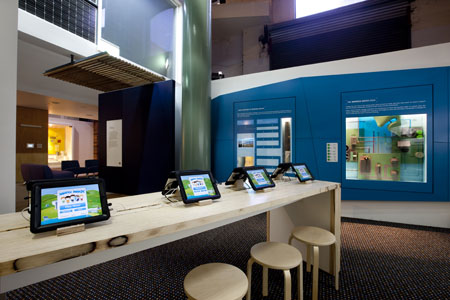
© Powerhouse Museum, Sydney
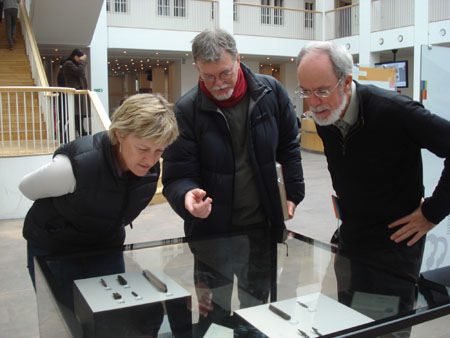
courtesy Libby Robin
Instead of a narrative exhibition story, as in Mission and to a lesser extent EcoLogic, Northern Worlds comprises three key topics that are the subjects of the research-in-progress:
- Climatic changes and society: when climatic boundaries move
- Farming on the edge: cultural landscapes of the north
- Social networks in the North: communication, trade and cultural markers.
Each of these includes a strong sense of the 'global story', but is nuanced (and peopled) by its closer study of cases in Greenland. The first topic deals with slices of time over the past 15,000 years, when rapid changes to the climate created and closed opportunities for prehistoric and historic societies: it is designed to give perspective to 'the influence of present-day climatic changes'.[1] The expansion of agriculture over more than 6000 years is the focus of the second topic, while the third is a social history of the cultural and trade-based networks of the 'marginal' northern people. This flexible low cost, small space exhibit — easily updated by new findings — is an imaginative solution for a museum to tackle the big question of climate change, without expensive exhibition furniture and interactive elements that break down and date quickly. The significant placement, right at the front door of the museum, in the grand entrance hall, gives gravitas to the museum's current research. The fact that it is a portable exhibit allowed the museum to travel it to Nuuk, Greenland for the summer of 2011.
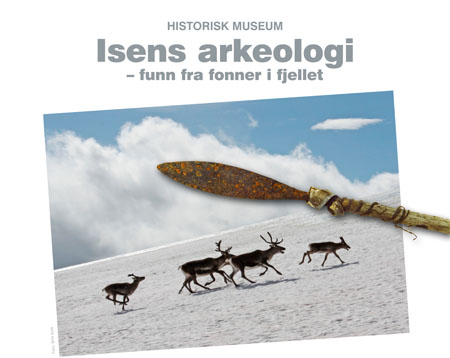
As we entered the new millennium, Nobel Prize winning chemist, Paul Crutzen, declared we were now in a new geological epoch, an era in which humanity has affected every global system on earth. He called it the 'Anthropocene', and dated its beginnings to the Industrial Revolution of the late eighteenth century.[11] In 2008, a group of geologists and other scientists supported Crutzen's view, but it is still strictly a hypothesis.[12] Geologists and earth scientists debate whether it should be considered an 'epoch', replacing the Holocene, or a new 'age' within the Holocene. But there is a widespread feeling that anthropogenic change is a major, new and accelerating phenomenon, and that it is forcing the next climate change event, which has already begun. If anthropogenic change is now shaping planetary systems, research on human societies in relation to past climates becomes part of our understanding how (or if) our own societies can adapt to present climates.
Describing changes to Earth's system over time demands understanding of the history of the biophysical factors, the human factors and their integration. There are, more than ever before, common interests between historians and non-historians, to think globally about history, and to integrate ideas across very different scales. We need more than just 'changing light bulbs', as Donna Green and Liz Minchin, authors of Screw Light Bulbs, put it.[13] Some argue that Homo sapiens is a creature of the late Pleistocene and Holocene, so it is questionable whether the species can survive the changes we ourselves have wrought on the planet. It is time to look at a history of humankind, a species that so successfully evolved for a particular planetary climate within a (relatively) narrow band of possibilities; possibilities that are now being exceeded and altered very quickly. It no longer makes sense to separate human from non-human nature.
Museums are well positioned to take up the challenge of the Anthropocene. So far, the story of 'living with climate change' has yet to be told comprehensively in any museum, but the most successful and interesting exhibitions feature local material that can cast new light on the global story. And to be a 'sustainable' exhibition, there needs to be fluidity and flexibility as the science and human stories are still unfolding. We, who work in museums that have a cultural or humanities tradition, need to engage actively with science, and make sure that the scientists understand and have access to our expertise. The idea of the Anthropocene can be enabling for this.
1 Mike Hulme, 'Meet the humanities', Nature Climate Change, vol. 1, June 2011, 177–9, doi:10.1038/nclimate1150 (p. 177).
2 My comments here are based on online material: www.klimapark2469.no and http://www.khm.uio.no/utstillinger2/oetzi/pressemelding.html; and scholarly literature: Brit Solli, Mats Burström, Ewa Domanska, Matt Edgeworth, Alfredo González-Ruibal, Cornelius Holtorf, Gavin Lucas, Terje Oestigaard, Laurajane Smith & Christopher Witmore, 'Some reflections on heritage and archaeology in the Anthropocene', Norwegian Archaeological Review, vol. 44, no. 1, June 2011, 40–88.
3
www.nrm.se/download/18.42129f1312d951207af800030357/2008+klimatFolder.pdf.
4 For discussion of the Resilience art show, see www.nma.gov.au/research/centre_for_historical_research/conferences_and_seminars/violent_ends2/the_art_of_resilience/.
5On the earlier version, see Sandra McEwen, Ecologic: Creating a Sustainable Future, Powerhouse Museum, Sydney, 2004. This reads like a teacher's handbook for the exhibition, and is described in the Preface as a way to reach audiences beyond the museum.
6
www.natmus.dk/sw60649.asp.
7 Nationalmuseet, Northern Worlds: The Interdisciplinary Research Initiative of the National Museum of Denmark, free brochure (in English), p. 2, n.d.
8 The English language version of the exhibition website is at http://www.khm.uio.no/utstillinger2/isens_arkeologi/english/1_introtekst.html.
9 Solli et al., 2011, p. 41.
10
www.oppland.no/no/Klimapark2469-English/News/The-Lendbreen-site/ (accessed 25 August 2011).
11 PJ Crutzen, 'Geology of mankind', Nature, no. 415, 2002 (p. 23); Robin, Libby & Will Steffen, 'History for the Anthropocene', History Compass, vol. 5, no. 5, 2007, (1694–1719); doi:10.1111/j.1478-0542.2007.00459.x
12 J Zalasiewicz, M Williams, A Smith, TL Barry, AL Coe, PR Bown, P Brenchley, D Cantrill, A Gale, P Gibbard, FJ Gregory, MW Hounslow, AC Kerr, P Pearson, R Knox, J Powell, C Waters, J Marshall, M Oates, P Rawson & P Stone, 'Are we now living in the Anthropocene?' GSA Today, vol. 18, no. 2, 2008, (4–8).
13 Donna Green & Liz Minchin, Screw Light Bulbs: Smarter Ways to Save Australians Time and Money, UWA Press, Perth, 2010.
